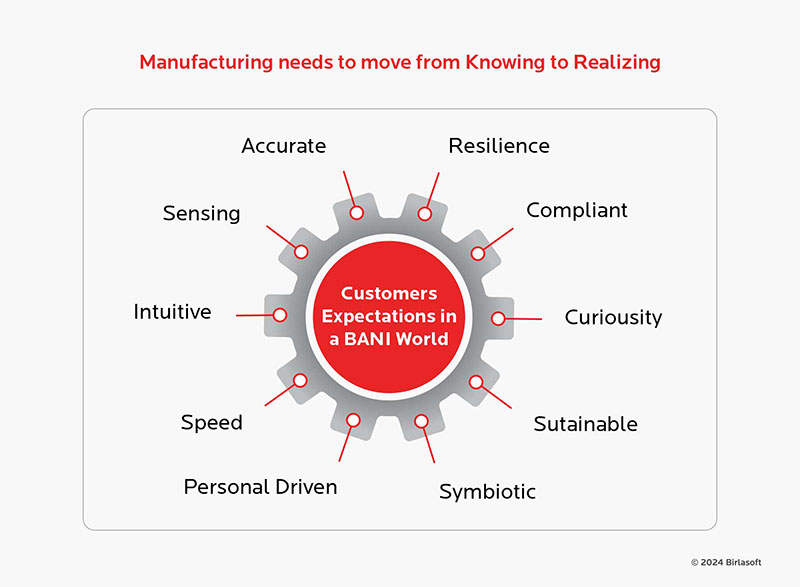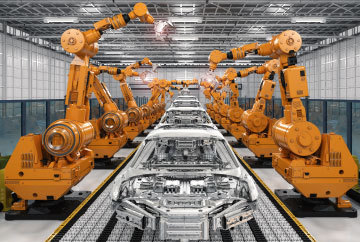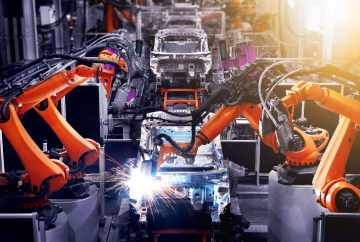Over the last few years, the manufacturing ecosystem has descended into a BANI world – one that is brittle, anxious, nonlinear, and incomprehensible. Economic uncertainty, geopolitical turbulence, climate change pressures, and internal disruption through technological innovation have consistently challenged incumbent strategic frameworks and unsettled established competitive dynamics.
Sentient Manufacturing – Purpose driven manufacturing that feels
Traversing a BANI World
Ever since the pandemic jeopardized a well-oiled business landscape with unprecedented challenges, businesses have faced one impediment after another. Here are some of these key difficulties:
- Economic Uncertainty: Sudden crashes due to war, inflation, and looming recession risks, can compromise seemingly stable markets.
- Supply Chain Disruptions: Unrelated events result in a nonlinear impact on complex supply chains – for instance, port congestion causing production delays.
- Unpredictable Geopolitics: Ongoing political tensions and strained relations between major economies make market access and sourcing uncertain.
- Climate and Sustainability: Extreme weather events due to climate change affect production, and sustainability imperatives are becoming urgent from a regulatory perspective.
All these factors contribute to an impending sense of anxiety about external factors that are out of control for manufacturing organizations.
Case in Point: Local Accident Shakes Global Supply Chains
Earlier this year, the Francis Scott Key Bridge located in Baltimore City in the United States collapsed after a 10,000 container-capacity vessel Dali collided with a bridge pillar. The event was termed a global crisis due to its wide-ranging impact – it caused daily losses of $15mn and affected 52.3mn tons of foreign cargo worth $80bn.
Most manufacturers are not equipped to thrive in such a world, because many still rely on legacy technology, processes, and frameworks that were devised for a different era of manufacturing.
Conquering the BANI World with Sentient Manufacturing
In this climate, the manufacturing industry needs to learn from the biological rules of evolution – proven over millions of years – and pivot to a sentient version of itself. This is the key to navigating the topology of a BANI world and thriving in the face of risk with resilience, agility, and bionic systems.
The Dawn of a New Era in Manufacturing: the Age of Purpose
Manufacturing organizations evolved from early industrial technology to digital orchestration in the Age of Information with Industry 4.0. This was followed by the Age of Intelligence, where machines could take on low-cognition human tasks. Technology advances in Information Technology, Energy & Clean Tech, BioTech and AI Technologies, have propelled Digital and Sustainable revolutions and ushered in a purpose revolution. In this Age of Purpose, we must ask ourselves what is necessary and pursue the same. Manufacturers need to adopt Sentient manufacturing, a new approach to manufacturing that involves continuously sensing, perceiving, acting, adapting, and responding to external stimuli with a level of empathy, tolerance and knowledge. In essence, manufacturing that feels.
Sentient Manufacturing Goes Beyond Reaction to Developing Instinct
Sentient manufacturing is a paradigm that infuses advanced technology into every facet of manufacturing operations, applies design thinking in building empathy across the organization, and leverages predictive systems to nurture intuition. Sentient manufacturing is a smart, well-integrated system of systems, which can make centralized and decentralized decisions by sensing changes in the external factors. It gives birth to a manufacturing enterprise that feels its environment, senses changing macro-factors, and evolves rapidly in response to these changes.
Key Pillars of Sentient Manufacturing
Transforming into a sentient manufacturing organization isn’t just a process – it results from a transformation that spans core processes, touching every aspect of the manufacturing value chain. A sentient manufacturing organization possesses a different DNA, one which can sense, and respond swiftly to seismic shifts.
Manufacturing needs to move from Knowing to Realizing

Strategic Advantages and Expected Outcomes
Sentient manufacturing can uplift the topline and bottom-line health of manufacturing businesses. It enables holistic outcomes like increased Overall Equipment Effectiveness (OEE), which results from optimal asset utilization, improved yields, and reduced downtime. These outcomes are achieved by reshaping manufacturing processes inside-out employing one or more of the above principles of sentient manufacturing, delivering measurable outcomes for clients. Some examples:
- Factory-of-the-Future: Building a symbiotic, risk-sensing, and self-healing factory with IoT and AI, transforming plant operations for a leading engine manufacturer in the Americas.
- Sustainability & Compliance: Addressing a leading LMV automotive manufacturer’s quality control challenges, resulting in up to a 30% reduction in rejection rates.
- Supplier Risk Radar: An intuitive application that monitors more than 25 signals, acting as an early warning system to help businesses sense and respond to seemingly unrelated disruptions impacting their supply chain.
- Omnichannel Experience: An empathetic and persona-driven approach that resulted in a 50% reduction in time-to-market and significant revenue gains for a major manufacturer of power generation systems.
- Intelligent Demand Forecasting: Delivering accuracy with an intelligent demand forecasting system, leading to better inventory planning, an 80% improvement in demand forecasting, increased ‘Perfect Order’ fulfillment, and fewer stock outages.
Our bMACH framework helps organizations transform into sentient manufacturing organizations. Among other outcomes, it also enables much-coveted supply chain outcomes, like reduced costs and increased inventory accuracy and turnover. Such outcomes – especially cost reductions, can yield a significant impact on the bottom line, as lowering supply chain costs by 5% can increase net profits by 2x1.
Sentient Manufacturing: Where to begin?
What we can’t measure, we can’t improve. From Sapience to Sentience, organizations need to make a journey in accordance with the way they are setup to operate, and their relative stage of evolution. The first and foremost step in this direction would be to assess the stage of maturity for manufacturing excellence across the whole value chain, right from engineering to Manufacturing to Aftermarket and beyond. Once we determine this and start looking at the real-world problems with the lens of a more purpose driven manufacturing, the possibilities for innovation are endless. This may also be defined by your organization priorities, budget constraints and technology limitations.
At Birlasoft, our ongoing research in manufacturing and a resilient 30-year journey as part of a 160-year-old multi-sector conglomerate, serving over 200 clients, provide us with a unique perspective on the manufacturing value chain. This perspective is crystallized into the BMACH framework and various supporting assessments, that help our clients determine their progress towards Sentience and realize the full potential of a Sentient Manufacturing organization, one step at a time!
More from this Author
Recommended
Manufacturing | 9 Min Read





